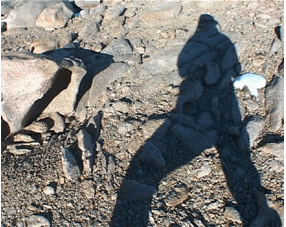Phil Dadson’s generous and soundswept spaces reinforce the idea of Antarctica as a site specifically designed for extreme experiences. I don’t want to go there, but nor do I want anyone else to. Barren places are best left to their own devices; however, a combination of conservation, tourism and surveillance appears to be the only means of keeping them that way. Artists have become part of that network.
Collectively called Polar Projects, Dadson’s suite of works was built from footage recorded over a single week of camping with science teams in the Taylor and Garwood Dry Valleys. It takes seriously the job of providing information, simulation and analysis. In some ways I felt I was back in the solemnities of 1970s conceptual art, walking around with a pair of headphones, with the artist’s voice telling me what was happening as he walked toward the glacier I can see to my left. With the headphones on, it was possible to walk to two other works as well, with the sound of snow and ice crunching underfoot. Discs demonstrate data about, for instance, the ozone layer; tracings record textures. The camera becomes the eye of the wind, forming ventifacts. The sounds of the works intersect, connecting the data and subverting its calm order.
More dramatically, “Chthonian pulse” is a large-scale three-screen projection that, through a simple tactic, brings to life the mythologies of the southern oceans. Its huge images suggest that the viewer might be emerging from Symme’s Hole, that sea once proposed within the Earth’s core. At other times one travels like some kind of swooping angel or bird. Passage through the terrain is emphasised; nothing is still and the spaces become enormously noisy as Dadson makes geomorphological change play its own discordant melodies. His strategic unravelling of different elements in the whole ecological debate is very effective. I still don’t want my presence to muddle the slow generation of forms in those fragile stone meadows, but I’m glad that this artist was there.
Lynn Taylor also takes seriously the job of reporting back. Invisible bridge is the record of a visit to a print studio in South Korea. In a gallery that retains its architectural form as two living-rooms, two rows of small blind, ie, non-inked but embossed, solar etchings, ring the space. On the floor a thin line of the small solar plates rims the room. There is a shelf for shoes at the door if you want to feel the plates through the soles of your feet. The etchings are details of digitally recorded images – fragments of texture, leaves, patterns, visual shapes given three-dimensionality through the print. The exhibition is structured through the formal rituals of encounter; gifts, the exchange of cards, the importance of touch and sight when common language is virtually non-existent.
A preceding exhibition in South Korea involved the same works. You can exchange a small packet for contact with one of the Korean people who have given their business cards for that purpose. Viewers on either side of the world now share knowledge of these soft white papers, delicately wrapped parcels and small metal plates, the same shape as calling cards and full of curious codes.
Both artists were publicly funded to go somewhere briefly, and present that place in a way that characterised it intelligibly. Each chose to convey an immersive experience based upon key elements of that encounter, broken into fragments and re-assembled as a collective massing of data, on the premise that the viewer would have to stop and concentrate, reading parts before wholes. Details make things seem real.
Article originally published in the New Zealand Listener
http://www.listener.co.nz
© APN Holdings NZ Ltd

